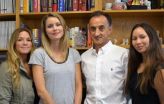(Press-News.org) LA JOLLA, CA—October 16, 2014—Scientists at The Scripps Research Institute (TSRI) have identified the long-sought activating molecules for a rare but crucial subset of immune system cells that help rally other white blood cells to fight infection.
In the process, the team also uncovered a previously unsuspected link between the mammalian immune system and the communication systems of simpler organisms such as bacteria.
The findings, published online ahead of print on October 16 by the journal Immunity, could lead to novel therapeutic approaches for diseases such as type 1 diabetes that are the result of immune system overactivity, as well as new ways to boost the effectiveness of vaccines, according to study leader Luc Teyton, a professor in TSRI's Department of Immunology and Microbial Science.
A Bridge
When a virus, bacteria or foreign substance invades the body, specialized cells known as dendritic cells present in the skin and other organs capture the trespassers and convert them into smaller pieces called antigens that they then display on their cell surfaces. White blood cells known as T and B cells recognize the antigens to launch very specific attacks on the invaders.
Dendritic cells also activate a specialized population of T cells known as natural killer T (NKT) cells. Once activated, NKT cells can commandeer the functions of dendritic cells to make them more effective and also recruit and coordinate the responses of T- and B-type cells.
"Because of their dual functions, NKT cells are a bridge between the body's innate immunity, which is characterized by rapid but less specific responses to pathogens, and adaptive or acquired immunity, which is composed of specialized white blood cells that can remember past invaders," Teyton said.
Previous studies indicated that NKT cells are activated by molecules known as glycolipids that dendritic cells produce and then display on their outer surfaces. It was widely assumed that the activating molecules were a class of glycolipids known as beta-glycosylceramides, an important component of nervous system cells.
However, this hypothesis had not been thoroughly examined, in part because there is no chemical test currently available to distinguish between two forms of the molecule that have slightly different configurations—beta-glycosylceramide and alpha-glycosylceramide. In addition, when scientists attempt to create either form synthetically for testing, there is always the possibility of small contamination of one by the other.
"When you're making glycolipids, there is no completely faithful way of controlling the form that you're making," Teyton said. "You're favoring the making of one, but you cannot say for sure that you don't have a small amount of the other form."
A Surprising Result
In their new study, Teyton and his colleagues, who included scientists from Brigham Young University, the La Jolla Institute for Allergy & Immunology and the University of Chicago, abandoned the chemical approach altogether. Instead, they combined a series of biochemical and biological assays to create a test that was sensitive enough to distinguish between the two different forms of glycolipids.
"Biological assays are exquisitely sensitive to low amounts of otherwise unmeasurable molecules," said study first author Lisa Kain, a research technician in Teyton's lab.
The scientists used custom antibodies to identify and eliminate alpha-glycosylceramides from their test batches. When the team was confident that their test batch contained only beta forms of the glycolipid, they tested it on NKT cells gathered from mice. To their surprise, however, nothing happened. Contrary to the conventional wisdom, the beta-glycosylceramides failed to activate the NKT cells.
"We were very skeptical about the early results," Teyton said. "We thought we had used the wrong antibody."
Next, the team combined enzymes designed to digest molecular linkages found only on beta-glycosylceramides with mice NKT cells inside test tubes. Surprisingly, the NKT cells were still being activated.
Finally, when the team used antibodies to disable alpha-glycosylceramides inside live mice, not only did the NKT cells fail to activate, they disappeared altogether from organs such as the thymus, where NKT cells are produced.
These multiple lines of evidence strongly indicated that it was the alpha form of the glycolipids that were the triggers for NKT cells. "What we thought was the contaminant turned out to be the activating molecule we were looking for," Teyton said.
New Therapies
The results were surprising for another reason. Until that moment, scientists did not think mammalian cells were capable of producing alpha forms of the glycolipids. The molecules were thought to exist only in bacteria and other simple organisms, which use them primarily as a means of communicating with one another. The findings thus suggest that the roots of a crucial part of the mammalian immune response are even more ancient than previously thought.
"Nobody expected this," Teyton said. "It's like discovering that all languages share a common origin."
Now that scientists know that alpha-glycosylceramides are made by our own body and activate NKT cells, they might be able to exploit it to create new therapies. For example, Teyton said, researchers could use enzymes to reduce alpha-glycosylceramide levels in order to suppress an overactive immune response, which happens with diseases such as type 1 diabetes. Or they could combine the molecules with antigens to create vaccines that elicit a faster and more efficient immune response.
"This opens up an avenue of new therapeutic approaches that we've never even thought about," Teyton said.
INFORMATION:
In addition to Teyton and Kain, authors of the new study, "The identification of the endogenous ligands of Natural Killer T cells reveals the presence of mammalian alpha-linked glycosylceramides," include Bill Webb, Marie Holt, Anne Constanzo, Kevin Self, Anais Teyton and Chris Everett of TSRI; Brian L. Anderson, Shenglou Deng and Paul B. Savage of Brigham Young University; Mitchell Kronenberg, Dirk M. Zajonc and Meng Zhao of La Jolla Institute for Allergy & Immunology; and Albert Bendelac of University of Chicago.
PITTSBURGH, Oct. 16, 2014 – Despite previous indications to the contrary, the esophagus does have its own pool of stem cells, said researchers from the University of Pittsburgh School of Medicine in an animal study published online today in Cell Reports. The findings could lead to new insights into the development and treatment of esophageal cancer and the precancerous condition known as Barrett's esophagus.
According to the American Cancer Society, more than 18,000 people will be diagnosed with esophageal cancer in the U.S. in 2014 and almost 15,500 people will ...
An international team of geologists has a new explanation for how the Midwest's biggest geological feature -- an ancient and giant 2,000-mile-long underground crack that starts in Lake Superior and runs south to Oklahoma and to Alabama -- evolved.
Scientists from Northwestern University, the University of Illinois at Chicago (UIC), the University of Gottingen in Germany and the University of Oklahoma report that the 1.1 billion-year-old Midcontinent Rift is a geological hybrid, having formed in three stages: it started as an enormous narrow crack in the Earth's crust; ...
MAYWOOD, Ill. (Oct. 16, 2014) -- As many as 35 percent of patients who undergo surgery to remove soft tissue sarcomas experience wound-healing complications, due to radiation they receive before surgery.
Now a study has suggested that a simple test called transcutaneous oximetry may be able to predict which of these patients are most likely to experience wound-healing complications, potentially enabling surgeons to take extra precautions.
Lukas Nystrom, MD, of Loyola University Medical Center presented his findings during the 2014 annual meeting of the Musculoskeletal ...
New Rochelle, NY, October 16, 2014—Delivering traditional emergency medical care at ground zero of natural disasters and military conflicts is challenging. First responders trained in simple integrative medicine approaches such as acupuncture, hypnosis, or biofeedback can provide adjunctive treatment to help relieve patients' pain and stress. How to teach and utilize modified techniques and their potential benefit are described in a Review article in Medical Acupuncture, a peer-reviewed journal from by Mary Ann Liebert, Inc., publishers. The article is available free ...
An article released by Social Forces titled, "Casual Contraception in Casual Sex: Life-Cycle Change in Undergraduates' Sexual Behavior in Hookups" by Jonathan Marc Bearak (New York University) explores the changes in undergraduate uncommitted sexual behavior during years 1–4 of college. The article provides reasoning for the decline in the use of condoms, and explains how changes in the odds of coitus and condom use depend on fam¬ily background, school gender imbalance, and whether the partners attend the same college.
The results show that the odds of unprotected ...
Lithium (Li)-ion batteries serve us well, powering our laptops, tablets, cell phones and a host of other gadgets and devices. However, for future automotive applications, we will need rechargeable batteries with significant increases in energy density, reductions in cost and improvements in safety. Hence the big push in the battery industry to develop an alternative to the Li-ion technology.
One promising alternative would be a battery based on a multivalent ion, such as magnesium (Mg). Whereas a Li-ion with a charge of +1 provides only a single electron for an electrical ...
Myths about the brain are common among teachers worldwide and are hampering teaching, according to new research.
Teachers in the UK, Holland, Turkey, Greece and China were presented with seven so-called 'neuromyths' and asked whether they believe them to be true.
A quarter or more of teachers in the UK and Turkey believe a student's brain would shrink if they drank less than six to eight glasses of water a day, while around half or more of those surveyed believe a student's brain is only 10 per cent active and that children are less attentive after sugary drinks and ...
October 16, 2014, Glenview, Illinois—The American College of Chest Physicians (CHEST) and the Canadian Thoracic Society (CTS) announced today the release of Prevention of Acute Exacerbation of Chronic Obstructive Pulmonary Disease: American College of Chest Physicians and Canadian Thoracic Society Guideline in the journal CHEST. The guideline, a first of its kind, provides evidence-based recommendations aimed at prevention of COPD exacerbations, which can cause frequent hospital readmissions, death during or after a hospital stay, and can potentially greatly reduce ...
HOUSTON – (Oct. 16, 2014) – While most Texans used healthcare.gov earlier this year to get information or to enroll in a health insurance plan under the Affordable Care Act (ACA), larger percentages of Texans found talking to the call center or a navigator was the most helpful. Those are just some of the lessons learned in a report released today by the Episcopal Health Foundation and Rice University's Baker Institute for Public Policy.
The report found 62 percent of Texans used the healthcare.gov website to learn about ACA Marketplace health plans during ...
Particle physicists have a hard time identifying all the elementary particles created in their particle accelerators. But now researchers at Chalmers University of Technology have designed a material that makes it much easier to distinguish the particles.
To investigate the matter's smallest constituents, physicists have particles colliding with each other at very high speeds, for example in the particle accelerator LHC at Cern. The collisions create bursts of common and rare particles, all invisible to the eye.
To identify them researchers need to detect the cone of ...




